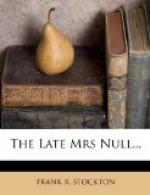“’Tain’t right,” she said to Uncle Isham when he arrived, “fur a pow’ful ole pusson like me to set out on a jarney ob dis kin’ ’thout ’ligious sarvices. ’Tain’t ’spectable.”
Uncle Isham rubbed his head a good deal at this remark. “Dunno wot we gwine to do ‘bout dat,” he said. “Brudder Jeemes lib free miles off, an’ mos’ like he’s out ditchin’. Couldn’t git him h’yar dis ebenin’, nohow.”
“Well den,” said Aunt Patsy, “you conduc’ sarvices yourse’f, Uncle Isham, an’ we kin have prar meetin’, anyhow.”
Uncle Isham having consented to this, he put his oxen under the care of a small boy, and collecting in Aunt Patsy’s room the five colored women and girls who were in attendance upon her, he conducted “prars,” making an extemporaneous petition which comprehended all the probable contingencies of the journey, even to the accident of the right wheel of the cart coming off, which the old man very reverently asserted that he would have lynched with a regular pin instead of a broken poker handle, if he could have found one. After the prayer, with which Aunt Patsy signified her entire satisfaction by frequent Amens, the company joined in the vigorous singing of a hymn, in which they stated that they were “gwine down to Jurdun, an’ tho’ the road is rough, when once we shuh we git dar, we all be glad enough; de rocks an’ de stones, an’ de jolts to de bones will be nuffin’ to de glory an’ de jiy.”
The hymn over, Uncle Isham clapped on his hat, and hurried menacingly after the small boy, who had let the oxen wander along the roadside until one wheel of the cart was nearly in the ditch. Aunt Patsy now partook of a collation, consisting of a piece of hoe-cake dipped in pork fat, and a cup of coffee, which having finished, she declared herself ready to start. A chair was put into the cart, and secured by ropes to keep it from slipping; and then, with two women on one side and Uncle Isham on the other, while another woman stood in the cart to receive and adjust her, she was placed in position.
Once properly disposed she presented a figure which elicited the lively admiration of her friends, whose number was now increased by the arrival of a couple of negro boys on mules, who were going to the post-office, it being Saturday, and mail day. Around Aunt Patsy’s shoulders was a bright blue worsted shawl, and upon her head a voluminous turban of vivid red and yellow. Since their emancipation, the negroes in that part of the country had discarded the positive and gaudy colors that were their delight when they were slaves, and had transferred their fancy to delicate pinks, pale blues, and similar shades. But Aunt Patsy’s ideas about dress were those of by-gone days, and she was too old now to change them, and her brightest handkerchief had been selected for her head on this important day. Above her she held a parasol, which had been graciously loaned by her descendant of the fourth generation. It was white, and lined with pink, and on the edges still lingered some fragments of cotton lace.




